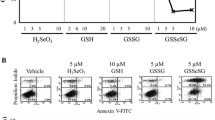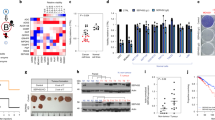Abstract
The mechanisms of sodium selenite-induced cell death in cervical carcinoma cells were studied during 24 h of exposure in the HeLa Hep-2 cell line. Selenite at the employed concentrations of 5 and 50 μmol/L produced time- and dose-dependent suppression of DNA synthesis and induced DNA damage which resulted in phosphorylation of histone H2A.X. These effects were influenced by pretreatment of cells with the SOD/catalase mimetic MnTMPyP or glutathione-depleting buthionine sulfoximine, suggesting the significant role of selenite-generated oxidative stress. Following the DNA damage, selenite activated p53-dependent pathway as evidenced by the appearance of phosphorylated p53 and accumulation of p21 in the treated cells. Concomitantly, selenite activated p38 pathway but its effect on JNK was very weak. p53- and p38-dependent signaling led to the accumulation of Bax protein, which was preventable by specific inhibitors of p38 (SB 203580) and p53 (Pifithrin-α). Mitochondria in selenite-treated cells changed their dynamics (shape and localization) and released AIF and Smac/Diablo, which initiated caspase-independent apoptosis as confirmed by the caspase-3 activity assay and the low effect of caspase inhibitors z-DEVD-fmk and z-VAD-fmk on cell death. We conclude that selenite induces caspase-independent apoptosis in cervical carcinoma cells mostly by oxidative stress-mediated activation of p53 and p38 pathways, but other selenite-mediated effects, in particular mitochondria-specific ones, are also involved.












Similar content being viewed by others
Abbreviations
- AIF:
-
apoptosis-inducing factor
- BA:
-
bonkrekic acid
- BrdU:
-
bromodeoxyuridine
- BSO:
-
buthionine sulfoximine
- Chaps:
-
3-[(3-cholamidopropyl)dimethylammonio]-1-propanesulfonic acid
- DAPI:
-
4′,6-diamidino-2-phenylindole
- DCF:
-
dichlorofluorescein
- DCFH/DA:
-
2′,7′-dichlorofluorescein diacetate
- DMEM:
-
Dulbecco’s modified Eagle’s medium
- DTNB:
-
5,5′-dithio-bis(2-nitrobenzoic acid)
- DTT:
-
dithiotreitol
- EDTA:
-
ethylenediaminetetraacetic acid
- GR:
-
glutathione reductase
- GSH:
-
reduced glutathione
- GSSH:
-
oxidized glutathione
- JNK:
-
Jun N-terminal kinase
- MnTMPyP:
-
Mn(III)tetrakis (1-methyl-4-pyridyl) porphyrin
- Pifithrin-α:
-
(2-(2-imino-4,5,6,7-tetrahydrobenzothiazol-3-yl)-1-p-tolylethanone, HBr)
- ROS:
-
reactive oxygen species
- SB:
-
203580 4-(4-fluorophenyl)-2-(4-methylsulfinylphenyl)-5-(4-pyridyl)-1H-imidazole
- selenite:
-
sodium selenite
- SP600125:
-
anthra[1,9-cd]pyrazol-6(2H)-one 1,9-pyrazoloanthrone
- z-DEVD-fmk:
-
Z-Asp-Glu-Val-Asp-fluoromethylketone
- z-VAD-fmk:
-
benzyloxycarbonyl-Val-Ala-Asp-fluoromethylketone
- β-NADPH:
-
beta-nicotinamide-adenine dinucleotide phosphate
References
Chung YW, Kim TS, Lee SY, Lee SH, Choi Y, Kim N, Min B-M, Jeong D-W, Kim IY. Selenite-induced apoptosis of osteoclasts mediated by the mitochondrial pathway. Toxicol Lett 2006;160:143–50.
Combs G Jr, Gray W. Chemopreventive agents: selenium. Pharmacol Ther 1998;79:179–92.
Dong H, Ying T, Li T, Cao T, Wang J, Yuan J, Feng E, Han B, Hua F, Yang Y, Yuan J, Wang H, Xu C. Comparative proteomic analysis of apoptosis induced by sodium selenite in human acute promyelocytic leukemia NB4 cells. J Cell Biochem 2006;98:1495–506.
Drake EN. Cancer chemoprevention: selenium as a prooxidant, not an antioxidant. Med Hypotheses 2006;67:318–22.
El-Bayoumy K, Sinha R. Mechanisms of mammary cancer chemoprevention by organoselenium compounds. Mutat Res 2004;551:181–97.
Ghose A, Fleming J, El-Bayoumy K, Harrison PR. Enhanced sensitivity of human oral carcinomas to induction of apoptosis by selenium compounds: involvement of mitogen-activated protein kinase and Fas pathways. Cancer Res 2001;61:7479–87.
Harrison PR, Lanfear J, Wu L, Fleming J, McGarry L, Blower L. Chemopreventive and growth inhibitory effects of selenium. Biomed Environ Sci 1997;10:235–45.
Hu H, Jiang C, Schuster T, Li G-X, Daniel PT, Lu J. Inorganic selenium sensitizes prostate cancer cells to TRAIL-induced apoptosis through superoxide/p53/Bax-mediated activation of mitochondrial pathway. Mol Cancer Ther 2006;5:1873–82.
Husbeck B, Peehl DM, Knox SJ. Redox modulation of human prostate carcinoma cells by selenite increases radiation-induced cell killing. Free Radic Biol Med 2005;38:50–7.
Ip C. Lessons from basic research in selenium and cancer prevention. J Nutr 1998;128:1845–54.
Jiang C, Wang Z, Ganther H, Lu J. Caspases as key executors of methyl selenium-induced apoptosis (anoikis) of DU-145 prostate cancer cells. Cancer Res 2001;61:3062–70.
Jiang C, Hu H, Malewicz B, Wang Z, Lu J. Selenite-induced p53 Ser-15 phosphorylation and caspase-mediated apoptosis in LNCaP human prostate cancer cells. Mol Cancer Ther 2004a;3:877–84.
Jiang C, Kim K-H, Wang Z, Lu J. Methyl selenium-induced vascular endothelial apoptosis is executed by caspases and principally mediated by P38 MAPK pathway. Nutr Cancer 2004b;49:174–83.
Jonsson-Videsater K, Bjorkhem-Bergman L, Hossain A, Soderberg A, Eriksson LC, Paul CH, Rosen A, Bjornstedt M. Selenite-induced apoptosis in doxorubicin-resistant cells and effects on the thioredoxin system. Biochem Pharmacol 2004;67:513–22.
Kim YS, Jhon DY, Lee KY. Involvement of ROS and JNK1 in selenite-induced apoptosis in Chang liver cells. Exp Mol Med 2004;36:157–64.
Li G-X, Hu H, Cheng J, Schuster T, Lü J. Differential involvement of reactive oxygen species in apoptosis induced by two classes of selenium compounds in human prostate cancer cells. Int J Cancer 2007;120:2034–43.
Lu J, Jiang C, Kaeck M, Ganther H, Vadhanavikit S, Clement IP, Thompson H. Dissociation of the genotoxic and growth inhibitory effects of selenium. Biochem Pharmacol 1995;50:213–19.
Meuillet E, Stratton S, Cherukuri DP, Goulet A-Ch, Kagey J, Porterfield B, Nelson MA. Chemoprevention of prostate cancer with selenium: an update on current clinical trials and preclinical findings. J Cell Biochem 2004;91:443–58.
Munoz-Pinedo C, Guio-Carrion A, Goldstein JC, et al. Different mitochondrial intermembrane space proteins are released during apoptosis in a manner that is coordinately initiated but can vary in duration. PNAS 2006;103:11573–8.
Neill MG, Fleshner NE. An update on chemoprevention strategies in prostate cancer for 2006. Curr Opin Urol 2006;16:132–7.
Nelson M, Goulet A-C, Jacobs E, Lance P. Studies into the anticancer effects of selenomethionine against human colon cancer. Ann NY Acad Sci 2005;1059w:26–32.
Park HS, Park E, Kim MS, et al. Selenite inhibits the c-Jun N-terminal kinase/stress-activated protein kinase (JNK/SAPK) through a thiol redox mechanism. J Biol Chem 2000;275:2527–31.
Rudolf E, Radocha J, Cervinka M, Cerman J. Combined effect of sodium selenite and camptothecin on cervical carcinoma cells. Neoplasma 2004;51:127–35.
Sarker KP, Biswas KK, Rosales JL, Yamaji K, Hashiguchi T, Lee KY, Maruyama I. Ebselen inhibits NO-induced apoptosis of differentiated PC12 cells via inhibition of ASK1-p38 MAPK-p53 and JNK signaling and activation of p44/42 MAPK and Bcl-2. J Neurochem 2003;87:1345–53.
Shilo S, Tirosh O. Selenite activates caspase-independent necrotic cell death in Jurkat T cells and J774.2 macrophages by affecting mitochondrial oxidant generation. Antioxid Redox Signal 2003;5:273–9.
Spallholz JE. On the nature of selenium toxicity and carcinostatic activity. Free Radic Biol Med 1994;17:45–64.
Stewart MS, Spallholz JE, Neldner KH, Pence BC. Selenium compounds have disparate abilities to impose oxidative stress and induce apoptosis. Free Radic Biol Med 1999;26:42–8.
Whanger PD. Selenium and its relationship to cancer: an update dagger. Br J Nutr 2004;91:11–28.
Zhong W, Oberley TD. Redox-mediated effects of selenium on apoptosis and cell cycle in the LNCaP human prostate cancer cell line. Cancer Res 2001;61:7071–8.
Acknowledgment
This work was supported by Ministry of Education Research Project MSM 0021620820.
Author information
Authors and Affiliations
Corresponding author
Rights and permissions
About this article
Cite this article
Rudolf, E., Rudolf, K. & Červinka, M. Selenium activates p53 and p38 pathways and induces caspase-independent cell death in cervical cancer cells. Cell Biol Toxicol 24, 123–141 (2008). https://doi.org/10.1007/s10565-007-9022-1
Received:
Accepted:
Published:
Issue Date:
DOI: https://doi.org/10.1007/s10565-007-9022-1




